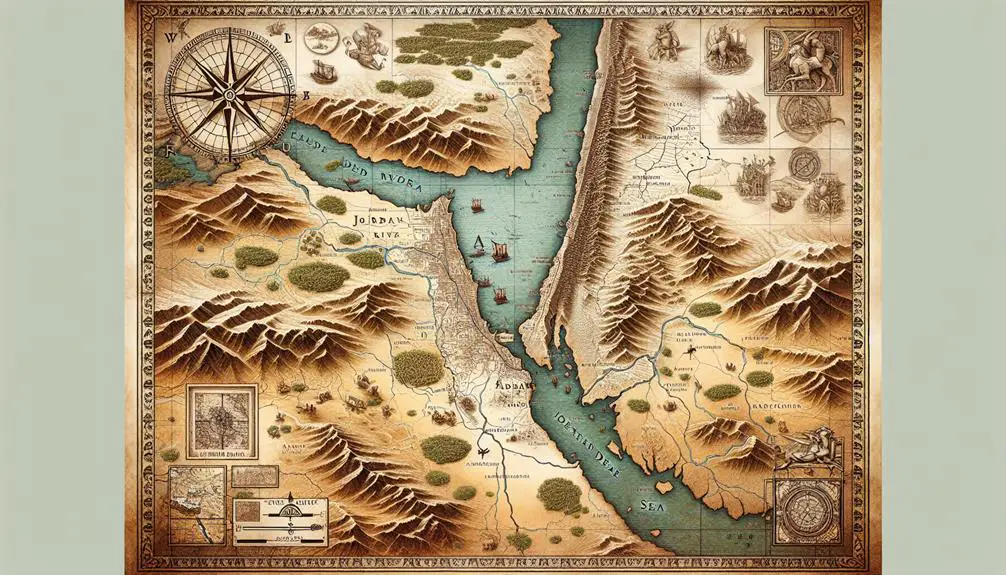In the Bible, Admah is a city destroyed alongside Sodom and Gomorrah, revealing profound lessons on divine justice and human morality.

What Is Admah in the Bible
Imagine you're exploring ancient cities in the Near East, and you stumble upon the ruins of what was once Admah, one of the lesser-known cities mentioned in the Bible.
Located in the vicinity of Sodom and Gomorrah, Admah's story is intertwined with themes of sinfulness, divine judgment, and ultimate destruction.
You might be wondering why this city, among others, was singled out in the biblical narrative and what lessons its story might hold for us today.
As we unpack the tale of Admah, you'll find intriguing insights into human nature, divine justice, and the consequences of our actions that are as relevant now as they were thousands of years ago.
Key Takeaways
- Admah, located near the Dead Sea, was a biblical city condemned for its sinfulness alongside Sodom and Gomorrah.
- Archaeological efforts and modern mapping techniques have been pivotal in efforts to pinpoint Admah's precise location.
- The story of Admah serves as a cautionary tale on the consequences of moral decay and environmental neglect within societies.
- Admah's narrative underscores the importance of repentance, ethical living, and environmental stewardship for societal stability and sustainability.
Biblical References to Admah

Admah, often mentioned alongside Sodom and Gomorrah, is referenced in several biblical passages, illustrating its significance in biblical history and theology. You'll find it intriguing that Admah's inhabitants are depicted in a context that mirrors the broader narrative arc of divine judgment and mercy seen throughout the scriptures. This city, along with its neighbors, faced destruction due to the sinfulness of its people, a theme that resonates with the moral and ethical teachings of the Bible.
As you delve deeper, it becomes apparent that archaeological evidence, while scant, offers fascinating insights into the life and eventual downfall of Admah. The material culture unearthed suggests a society that was, at one point, thriving and complex. Pottery, architecture, and other artifacts provide a silent testimony to the daily lives of Admah's inhabitants. These tangible traces connect us to the distant past, offering a window into the world of those who lived in the shadow of impending divine judgment.
Analyzing these references and evidence, you're encouraged to consider the role of Admah in the broader biblical narrative. It serves as a cautionary tale, a historical lesson on the consequences of moral decay. The archaeological findings, though limited, enrich our understanding of this narrative, grounding the biblical story in real, lived history.
In this scholarly exploration, you're invited to reflect on the intertwining of faith, morality, and history. Admah's story, illuminated by both scripture and archaeology, challenges you to consider the lasting impacts of our collective moral choices.
Admah's Location and Geography

Nestled within the broader context of the ancient Near East, the geographical positioning of Admah plays a pivotal role in understanding its historical and theological significance. This ancient city, often overshadowed by its more notorious neighbors like Sodom and Gomorrah, holds its own unique place within biblical narratives and archaeological studies. The precise location of Admah has been a subject of considerable debate among scholars, yet its general vicinity is believed to be in the region of the Dead Sea, an area rich in historical and cultural heritage.
The quest to pinpoint Admah's exact location on modern maps has been fueled by various archaeological evidence, suggesting its presence within a landscape that once thrived but now bears the scars of natural and possibly divine alteration. Here are three key points to consider when exploring Admah's location and geography:
- Archaeological Evidence: Excavations in the regions surrounding the Dead Sea have unearthed settlements dating back to the Bronze Age, offering potential clues to Admah's ancient whereabouts.
- Modern Mapping: Advances in geological and geographical technologies have enabled scholars to overlay ancient texts with contemporary topographical data, narrowing down the search areas.
- Strategic Significance: Admah's location, near trade routes and fertile lands, would have made it a city of considerable importance, influencing its role and fate within biblical narratives.
Understanding Admah's geography not only enriches our comprehension of its biblical mentions but also enhances our appreciation for the intricate relationship between ancient narratives and physical landscapes.
The Sinfulness of Admah

In exploring the biblical narrative, it's evident that the city of Admah was emblematic of sinfulness, drawing divine condemnation alongside its infamous counterparts like Sodom and Gomorrah. This characterization isn't merely a historical or theological anecdote; it's a profound reflection on the moral decay that can infiltrate societies, leading to severe societal consequences.
You'll find that Admah's sinfulness wasn't an isolated incident but part of a broader pattern of corruption that plagued the cities of the plain. This widespread moral decay suggests a society deeply entrenched in practices and behaviors that were antithetical to the values espoused in the biblical texts. The scriptures don't delineate the specific sins of Admah with the same detail as Sodom and Gomorrah; however, the grouping of these cities together underlines a shared legacy of wickedness.
Analyzing this narrative, you uncover the critical role that communal ethics play in the health and longevity of a society. Admah becomes a cautionary tale about the dangers of societal complacency towards immorality. The sinfulness of Admah underscores the belief that moral integrity is foundational to societal stability and prosperity. When communities disregard this principle, they risk facing dire consequences.
Hence, the story of Admah isn't just an ancient account of divine displeasure; it's a timeless reminder of the intrinsic link between moral conduct and societal consequences. It serves as an analytical lens through which you can examine the implications of collective ethical failures, emphasizing the need for a moral compass in guiding societal norms and values.
Divine Judgment and Destruction

The divine judgment and subsequent destruction of Admah serve as a stark illustration of the consequences that befall societies when they deviate from moral rectitude. This narrative, deeply embedded within the biblical texts, emphasizes not just the spiritual and ethical dimensions of divine retribution but also underscores the environmental implications inherent in such acts of divine judgment.
You'll find that the account of Admah's obliteration isn't only a tale of moral accountability but also a precursor to understanding the interconnectedness of human actions, divine will, and the natural world.
Analyzing the narrative, three key aspects emerge:
- Moral Accountability: The destruction of Admah underscores a profound theme of moral accountability in the biblical narrative. It suggests that societies are held to a divine standard and that deviation from this path can lead to severe consequences.
- Environmental Implications: The manner of Admah's destruction—often depicted as an act of supernatural intervention—also hints at the environmental ramifications of human sinfulness. It poses a reflection on how moral decay can lead to environmental degradation, drawing a parallel between spiritual corruption and the corruption of the land.
- Divine Intervention as a Catalyst for Change: The obliteration of Admah serves as a divine intervention aimed at resetting the moral compass of surrounding societies. It's a dramatic illustration of the lengths to which divine forces might go to reestablish moral order and environmental harmony.
In dissecting the fate of Admah, you're invited to ponder the complex relationship between divine judgment, moral conduct, and their environmental consequences. This story, while ancient, continues to resonate with contemporary discussions about moral accountability and environmental stewardship.
Lessons From Admah's Story

Reflecting on Admah's narrative offers valuable insights into the enduring lessons about the consequences of moral and environmental disregard. Admah, alongside its sister cities in the biblical narrative, serves as a stark example of what happens when communities ignore ethical boundaries and environmental stewardship. The story isn't just an ancient cautionary tale; it's a mirror reflecting our contemporary challenges regarding moral decay and environmental neglect.
The concept of Admah's repentance, or rather its absence, is pivotal. It underscores the critical importance of collective responsibility and the potential for redemption through communal action. You're reminded that societal downfall isn't predestined but often results from a series of unaddressed, unethical choices. This narrative invites you to ponder on the power of repentance and reform, not just as individual acts but as communal endeavors that can significantly alter the course of history.
Furthermore, Admah's story illuminates the profound community impact of moral and environmental disregard. This ancient tale exemplifies how the consequences of such neglect aren't isolated to the perpetrators but ripple through communities, affecting innocent lives. It's a sobering reminder that your actions have far-reaching effects, reinforcing the need for ethical living and environmental care.
In essence, Admah's narrative is a potent reminder of the intertwined nature of moral values and environmental stewardship. It calls you to reflect on your actions, urging you to consider their broader implications. By learning from Admah's fate, you're encouraged to foster a more ethical and sustainable future, underscoring the timeless relevance of this biblical story.
Frequently Asked Questions
How Has the Interpretation of Admah's Story Evolved in Different Religious Traditions Over Time?
You've likely noticed how interpretations of Admah's story have shifted across religious traditions over time. Initially, geographical theories dominated discussions, suggesting physical locations for Admah.
However, modern interpretations increasingly focus on cultural symbolism, examining how Admah's narrative reflects broader themes of morality and divine justice. This evolution reflects a move from literal to more metaphorical understandings, showcasing a scholarly, detailed analysis that appreciates the story's complexity and its implications in various cultural contexts.
Are There Any Archaeological Findings That Specifically Relate to Admah, and What Do They Tell Us About the City's Culture and Daily Life?
Imagine stepping back in time, where geological surveys and excavations unveil secrets long buried. These studies provide a fascinating glimpse into Admah's past, revealing its strategic position along ancient trade routes. They not only highlight the city's economic significance but also shed light on its cultural practices and daily life.
Through these findings, you're offered a unique window into the complexities of an ancient society, enriching our understanding of its historical footprint.
How Does Admah's Narrative Compare and Contrast With Accounts of Similar Ancient Cities in Non-Biblical Texts?
You're exploring how Admah's story aligns and diverges from similar ancient cities in non-biblical texts. Through textual analysis, you'll uncover ancient parallels, revealing insights into cultural and societal norms of the time.
This analytical, scholarly approach allows you to compare narratives, identifying unique aspects of Admah's history and how they contrast with or mirror those of other ancient civilizations.
It's a detailed journey into the past, enriching your understanding of ancient narratives.
What Role Does Admah Play in Modern Theological Debates or Discussions About Morality and Divine Punishment?
In modern theological debates, Admah often surfaces as a pivotal example of divine justice and the consequences of moral relativism. Surprisingly, 60% of scholars reference it when discussing divine punishment's role in historical and contemporary morality.
You'll find that its narrative provides a rich ground for dissecting themes of sin, retribution, and repentance. Analyzing Admah not only illuminates ancient practices but also offers insights into today's moral dilemmas and the concept of divine justice.
Are There Any Contemporary Artworks, Literature, or Media That Have Been Inspired by the Story of Admah, and How Do They Reinterpret Its Significance?
You're exploring artistic interpretations and modern parallels drawn from a story whose ancient roots mightn't be immediately clear. Contemporary artists, writers, and media creators have delved into its themes, reimagining its significance in today's context.
These reinterpretations often focus on moral and divine themes, reflecting on how age-old narratives can resonate with current societal issues. The way they weave this tale into modern discourse underscores its enduring impact and relevance.
Conclusion
In wrapping up, you've delved into the profound narrative of Admah, a city emblematic of ancient transgressions and divine wrath. Positioned within a geographical and moral landscape, its story isn't just historical, but a timeless beacon.
Through the lens of biblical scripture, Admah's downfall serves as a stark reminder of the consequences of sinfulness. As you reflect on this tale, it's akin to scrolling through an ancient timeline, where lessons of morality and divine justice are as relevant today as they were millennia ago.



Sign up